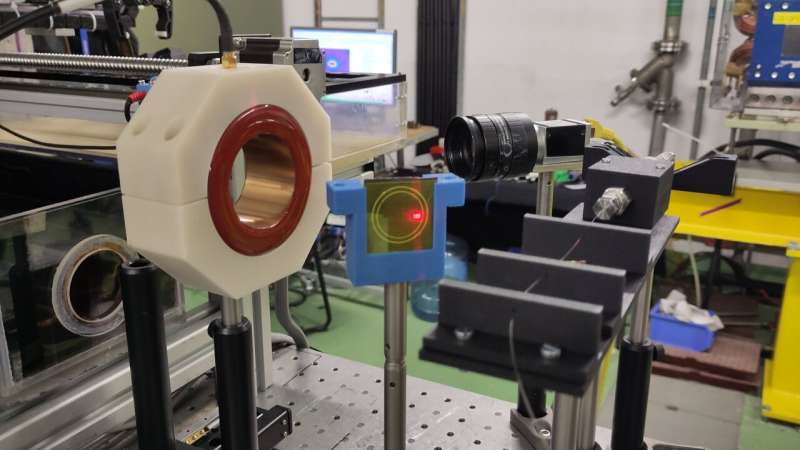Science
Hollow-Core Optical Fibers Enhance Radiation Monitoring at CERN

A team of scientists at the European Organization for Nuclear Research (CERN) is testing hollow-core optical fibers that could significantly improve the monitoring of particle beams in high-radiation environments. These innovative sensors, no thicker than a human hair, are designed to operate within particle accelerators and could enhance the precision of beam profiling and positioning, particularly in the Super Proton Synchrotron, CERN’s second-largest accelerator.
Unlike traditional optical fibers that guide light through solid glass, hollow-core fibers utilize a microstructured design that allows light to travel through a gas-filled core. This design employs resonance–antiresonance effects on the electromagnetic field, enabling the fibers to function effectively in extreme radiation conditions. By filling these fibers with a scintillating gas, which emits flashes of light upon interaction with radiation, researchers can develop a robust yet straightforward radiation sensor. This advancement may allow for real-time measurement of beam doses, an essential factor for both experimental and medical applications.
Enhancing Precision in High-Radiation Environments
Accurate measurement of particle beams is critical for both experimental physicists and beam physicists. The operation of CERN’s accelerators relies on extensive data collected from thousands of beam sensors distributed throughout the machines. Current sensors, such as multi-wire proportional chambers and scintillator detectors, may become unreliable under high energy or intensity conditions. This challenge extends to scientists developing accelerators for medical purposes, particularly in techniques like FLASH radiotherapy, which delivers radiation at ultra-high doses and shows promise for cancer treatment.
To address these issues, CERN’s diagnostics team is exploring new tools capable of withstanding extreme radiation. By combining expertise in accelerator technology with medical research, the project aims to support the safe delivery of FLASH therapy to patients. Testing for this innovative concept took place at various CERN facilities, including the CLEAR facility, during 2024 and 2025.
Promising Results from Initial Tests
In a series of experiments, a fiber filled with an argon–nitrogen mixture was exposed to an electron beam and connected to a silicon photomultiplier, a device capable of detecting single photons. Each interaction with the electron beam caused the gas within the fiber to emit light, which was then transmitted to the detector. The findings, presented at the International Beam Instrumentation Conference, yielded promising results.
“The fiber’s measurements of the beam profile closely matched those from a traditional YAG screen, which glows when struck by particles,” said Inaki Ortega Ruiz, who oversees beam instrumentation in the SPS North Experimental Area. Notably, even after exposure to radiation levels that could damage many conventional instruments, the hollow-core fiber showed no signs of performance degradation.
These initial results provide a foundation for further research, including enhancing the connection between the fiber and the detector, testing sealed fibers pre-filled with gas, and evaluating the long-term radiation hardness of the fibers. The continued development of this technology holds significant promise for both particle physics and medical applications, potentially revolutionizing how radiation is monitored in various environments.
-

 Health3 months ago
Health3 months agoNeurologist Warns Excessive Use of Supplements Can Harm Brain
-

 Health3 months ago
Health3 months agoFiona Phillips’ Husband Shares Heartfelt Update on Her Alzheimer’s Journey
-

 Science1 month ago
Science1 month agoBrian Cox Addresses Claims of Alien Probe in 3I/ATLAS Discovery
-

 Science1 month ago
Science1 month agoNASA Investigates Unusual Comet 3I/ATLAS; New Findings Emerge
-

 Science4 weeks ago
Science4 weeks agoScientists Examine 3I/ATLAS: Alien Artifact or Cosmic Oddity?
-

 Entertainment4 months ago
Entertainment4 months agoKerry Katona Discusses Future Baby Plans and Brian McFadden’s Wedding
-

 Science4 weeks ago
Science4 weeks agoNASA Investigates Speedy Object 3I/ATLAS, Sparking Speculation
-

 Entertainment4 months ago
Entertainment4 months agoEmmerdale Faces Tension as Dylan and April’s Lives Hang in the Balance
-

 World3 months ago
World3 months agoCole Palmer’s Cryptic Message to Kobbie Mainoo Following Loan Talks
-

 Science4 weeks ago
Science4 weeks agoNASA Scientists Explore Origins of 3I/ATLAS, a Fast-Moving Visitor
-

 Entertainment4 months ago
Entertainment4 months agoLove Island Star Toni Laite’s Mother Expresses Disappointment Over Coupling Decision
-

 Entertainment3 months ago
Entertainment3 months agoMajor Cast Changes at Coronation Street: Exits and Returns in 2025









